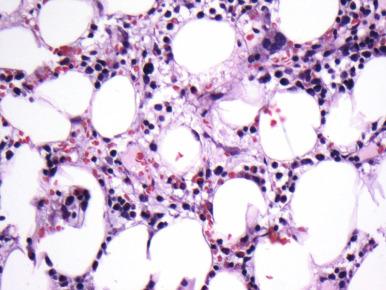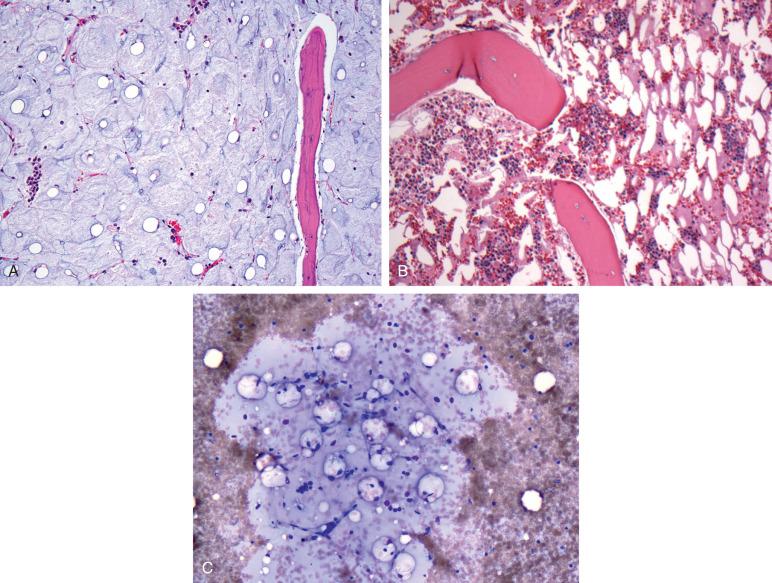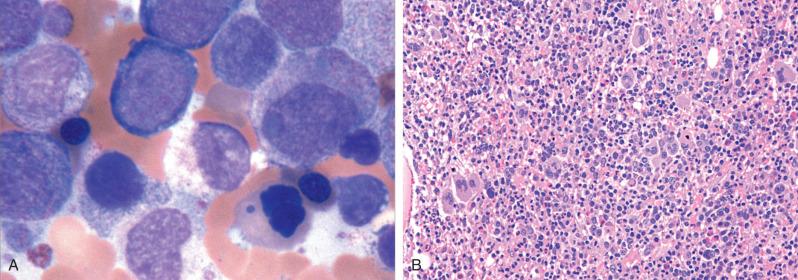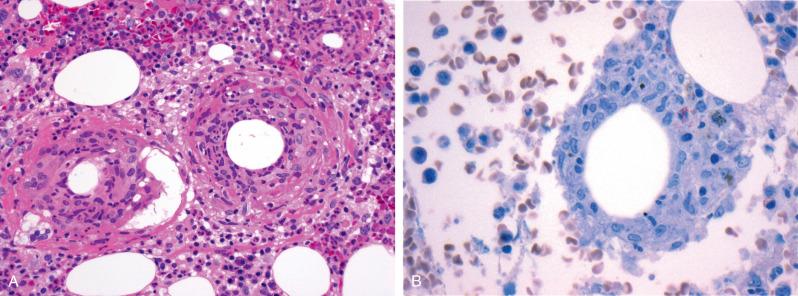Physical Address
304 North Cardinal St.
Dorchester Center, MA 02124
The bone marrow and spleen may be affected by a wide variety of infectious agents. Pathologists must be aware of the clinical concern for infection to initiate appropriate studies to detect microorganisms and be prepared to recognize features of infection even when it is not clinically suspected. Bone marrow sampling may be performed to evaluate fever of unknown origin (most commonly in immunosuppressed patients but sometimes in immunocompetent patients) or to evaluate for systemic infection in a patient known or suspected to harbor a particular infectious agent. Anemia and other peripheral cytopenias are the most frequent indications for bone marrow sampling and may be the presenting signs of a clinically unsuspected infection identifiable within the bone marrow.
Bone marrow morphologic changes related to infections are most often nonspecific, and confirmation of a specific infectious agent may require special stains, immunohistochemistry, microbiologic cultures, serologic studies, and molecular studies. However, it is important to understand the spectrum of morphologic changes elicited by specific infectious agents and to recognize how comparable changes can at times be caused by noninfective or neoplastic processes. The first part of this chapter discusses the various patterns of bone marrow changes that can be associated with infections; although most are nonspecific, in some instances they suggest a particular causative agent and can elicit appropriate confirmatory ancillary studies. In the second part of the chapter, the pathologies of specific infectious agents involving the bone marrow are described. Infections involving the spleen are discussed at the end of the chapter.
Bone marrow cellularity (i.e., the percentage of cellular marrow elements occupying the hematopoietic marrow space of the bone marrow biopsy specimen) is frequently increased in infection. This may reflect either an appropriate reaction against the offending agent or ineffective hematopoiesis due to the effects of the infectious agent on the maturing hematopoietic cells and marrow microenvironment. In the former situation, the peripheral smear shows leukocytosis, often with increased band neutrophils, circulating immature myeloid elements, neutrophil toxic granulation, or some combination of these characteristics. If ineffective hematopoiesis is present, leukopenia or pancytopenia may be present despite the marrow hypercellularity. The marrow may show hyperplasia of all lineages, or it may show relative myeloid, erythroid, or megakaryocytic hyperplasia. Although the type of hyperplasia is not specific for any particular infectious agent, marked myeloid hyperplasia is often seen in sepsis, and the bone marrow in a region affected by osteomyelitis may show a marked predominance of neutrophils. Megakaryocytic hyperplasia is frequently observed in human immunodeficiency virus (HIV) infection (see later discussion).
Global marrow hypocellularity may occur in severe, overwhelming infections, such as sepsis; in such cases of acute marrow injury, a necrotic background of eosinophilic granular material, reflecting products of massive cell death, may be observed ( Fig. 13.1 ). Marked erythroid hypoplasia or pure red cell aplasia (defined as <5% red cell precursors in the bone marrow) can be produced by a variety of infectious agents but is commonly associated with parvovirus B19 infection. Dengue hemorrhagic fever, caused by a single-stranded RNA flavivirus that can infect hematopoietic cells, is associated with cytopenias and marked bone marrow hypocellularity, often with a maturation arrest in erythroid and myeloid lineages. Aplastic anemia may occur after acute hepatitis (including hepatitis A, B, and C viruses); the mechanism of marrow failure and definite implication of a viral etiology are uncertain in these cases.

Serous atrophy of the bone marrow represents an alteration of the bone marrow stroma whereby the adipocytes and hematopoietic cells are replaced by pale pink, amorphous, extracellular ground substance. The adipocytes are often smaller in size than normal marrow adipocytes. Serous atrophy can be observed in late stages of HIV infection; in that context, it is always associated with anemia (usually severe, with a median hemoglobin concentration of 7.9 g/dL) or, less often, with other cytopenias. The bone marrow aspirates are typically difficult to obtain and may result in a dry tap. If an aspirate is obtained, gelatinous pink material may be present in the background of the Wright-Giemsa–stained smears. In the trephine biopsy on hematoxylin and eosin (H&E) stain, the material appears amphophilic or eosinophilic and homogeneous, although a fibrillar or granular appearance may be observed on high power ( Fig. 13.2 ). This contrasts to the eosinophilic background material of acute marrow injury (such as that observed after cytotoxic chemotherapy), which is granular at low power and appears to be more eosinophilic than serous atrophy material. The material in serous atrophy stains with periodic acid–Schiff (PAS) stain and is also positive for alcian blue at acidic pH (2.5 and 1.0). Because predigestion with hyaluronidase abrogates the alcian blue staining, serous atrophy material appears to comprise the extracellular ground substances hyaluronic acid and sulfated glycosaminoglycans. Disruption of the normal extracellular matrix in the marrow microenvironment likely explains the ineffective erythropoiesis and marked anemia typically associated with serous atrophy. The marrow is hypocellular in approximately half of the cases and may occasionally be hypercellular. Serous atrophy may be either focal or diffuse (see Fig. 13.2B ). When associated with HIV infection, megakaryocytes are usually increased and show the typical abnormal features observed in HIV-infected patients (see later discussion).

Serous atrophy may also occur in HIV-negative patients. Indeed, some reports have suggested that, since the advent of highly active antiretroviral therapy (HAART), HIV infection has become a relatively uncommon cause of serous atrophy ; cachexia due to tumors or malnutrition was a more common cause in one series. Other infections associated with serous atrophy include bacterial endocarditis, pneumonia, and tuberculosis. In such cases the histologic features are similar to those of HIV-associated serous atrophy, but serous atrophy in HIV-negative patients is associated with less marked anemia.
Myelodysplastic syndromes (MDS) characteristically exhibit morphologic abnormalities of the erythroid, myeloid, and megakaryocytic lineages, reflecting abnormal maturation of the clonal, defective hematopoiesis. These changes include nuclear irregularities, nuclear fragmentation, binucleation, megaloblastoid change, and cytoplasmic vacuolation of erythroid elements; hypogranularity, vacuolization, and abnormal nuclear lobation of myeloid cells; and small size and nuclear hypolobulation of megakaryocytes. Reactive conditions that disrupt the marrow microenvironment, including many inflammatory and infectious processes, may produce morphologic changes resembling those of MDS. In particular, the erythroid cells of HIV-positive patients often exhibit nuclear irregularities, megaloblastic change, vacuolation, and, occasionally, ring sideroblasts on iron stain ( Fig. 13.3A ). The megakaryocytes in HIV-positive patients are frequently small and increased in number (see Fig. 13.3B ). The megakaryocytes have very sparse cytoplasm (so-called naked or bare megakaryocyte nuclei) but do not typically show the round nuclei of MDS. In contrast to many cases of MDS, the myeloid lineage is usually spared. Hematopoietic elements also show a lower rate of proliferation and apoptosis in HIV infection than in MDS. These morphologic changes are reversible after treatment of HIV infection, because they reflect a disrupted bone marrow microenvironment rather than an intrinsic, clonal hematopoietic stem cell abnormality as seen in MDS. Nevertheless, HIV infection should be considered in the differential diagnosis of bone marrow samples showing dysplastic changes, particularly if the dysplasia is most prominent in the erythroid lineage, if it is accompanied by numerous bare megakaryocyte nuclei and increased plasma cells, and if it occurs in young patients, in whom MDS is uncommon.

Similar to HIV infection, a reactive morphologic dysplasia of erythroid elements may be observed in other infections involving the bone marrow, such as leishmania. The morphologic dysplasia in HIV and other infections is most likely due to effects of the infection on histiocytes, macrophages, and marrow stromal cells; these cells provide important microenvironmental structural and cytokine factors required for normal maturation of hematopoietic elements.
Aggregates of small, mature lymphocytes (that may or may not contain germinal centers) are nonspecific and can occur in normal individuals, as well as in a variety of neoplastic and nonneoplastic conditions. Lymphoid aggregates in the setting of HIV infection are often large, are admixed with histiocytes and plasma cells, and have ill-defined borders; they may occasionally be paratrabecular, mimicking lymphomatous aggregates. Flow cytometry and/or immunohistochemistry on bone marrow can be helpful in such cases to exclude the possibility of lymphomatous involvement of the bone marrow.
Granulomas are identified in approximately 1% of bone marrow samples and in approximately 20% of samples taken to evaluate a fever of unknown origin. Granulomas are readily identified in trephine biopsy sections but are only infrequently identifiable in the aspirate smears. Granulomas are usually not well represented in the aspirate smear due to associated reticulin fibrosis that limits aspiration of the telltale histiocytic and giant cell aggregates. An associated infection is diagnosed in only approximately 30% of bone marrow granuloma cases. In many cases, bone marrow granulomas are the result of noninfectious processes, including sarcoidosis, drug reactions, and paraneoplastic phenomena caused by hematologic or nonhematologic malignancies. In up to 5% of cases, bone marrow granulomas are idiopathic with no known cause identified.
The pattern of granulomas, including the ratio of histiocytes to lymphocytes and the presence or absence of multinucleated giant cells, eosinophils, and plasmacytosis, does not appear to be predictive of an infectious versus a noninfectious etiology. However, granuloma localization within the marrow can be helpful because the granulomas in Mycobacterium tuberculosis infections are often paratrabecular. M. tuberculosis infection in the marrow may also demonstrate bone marrow necrosis. Granulomas are most commonly associated with mycobacterial and fungal infections but can also occur with other infections, including Epstein-Barr virus (EBV), leishmaniasis, toxoplasmosis, brucellosis, and Q fever.
Diffuse histiocytosis in the absence of granulomas may occur in immunosuppressed patients with mycobacterial infections. Acid-fast bacilli (AFB) stain should be performed on samples from any immunosuppressed patient with increased bone marrow histiocytes or unexplained lymphohistiocytic aggregates. Whipple disease can rarely involve the bone marrow as histiocytosis containing PAS-positive inclusions and occasionally PAS-positive Tropheryma whipplei organisms. Whipple disease can also present with noncaseating granulomas in the bone marrow Although the presence of PAS-positive inclusions in bone marrow macrophages is nonspecific, it may raise the differential diagnosis of Whipple disease, which can be confirmed by polymerase chain reaction (PCR) or additional clinical investigations.
Bone marrow fibrin ring granulomas (also called doughnut granulomas) represent a distinctive type of granuloma associated with cytomegalovirus (CMV), EBV, and Q fever (caused by the rickettsial organism, Coxiella burnetii ), and Rickettsia typhi. Fibrin ring granulomas represent annular granulomas composed of concentric rings of neutrophils and epithelioid histiocytes surrounding a central empty space ( Fig. 13.4 ). The granulomas are often encircled by a lamellated ring of fibrin (highlighted by Masson trichrome or fibrin stains). The nature of the central clear space is uncertain; in the bone marrow and liver, the fibrin ring granulomas are typically located adjacent to blood vessels or sinusoids and have been termed a perivasculitis. However, the central material appears to be lipid rather than a vascular lumen because vascular components have not been identified within ring granulomas. Of note, fibrin ring granulomas are not specific for an infectious process because they also may occur as a paraneoplastic phenomenon in lymphomas. Hodgkin lymphoma must always be considered when granulomas are present in the marrow or spleen.

Become a Clinical Tree membership for Full access and enjoy Unlimited articles
If you are a member. Log in here